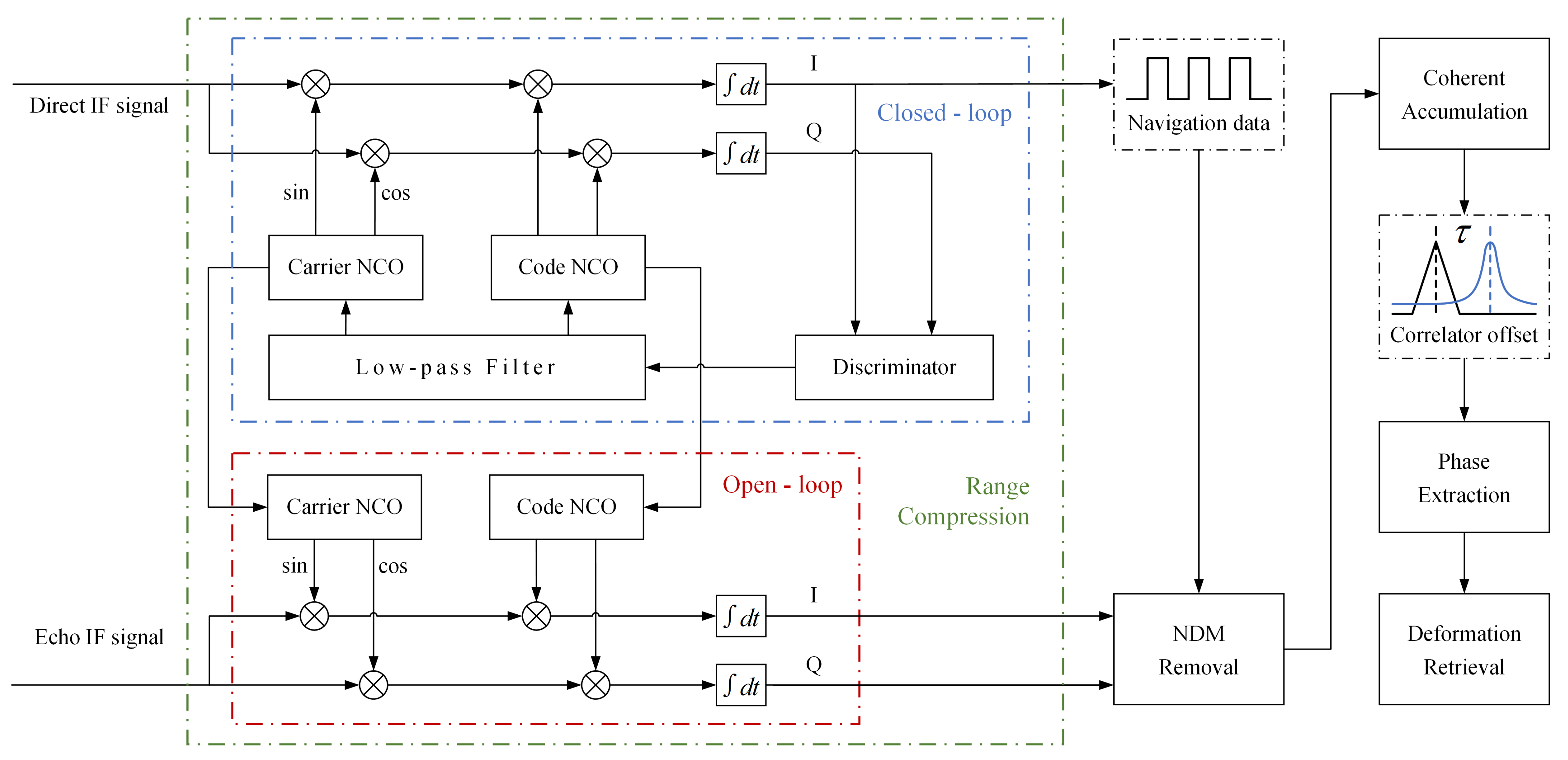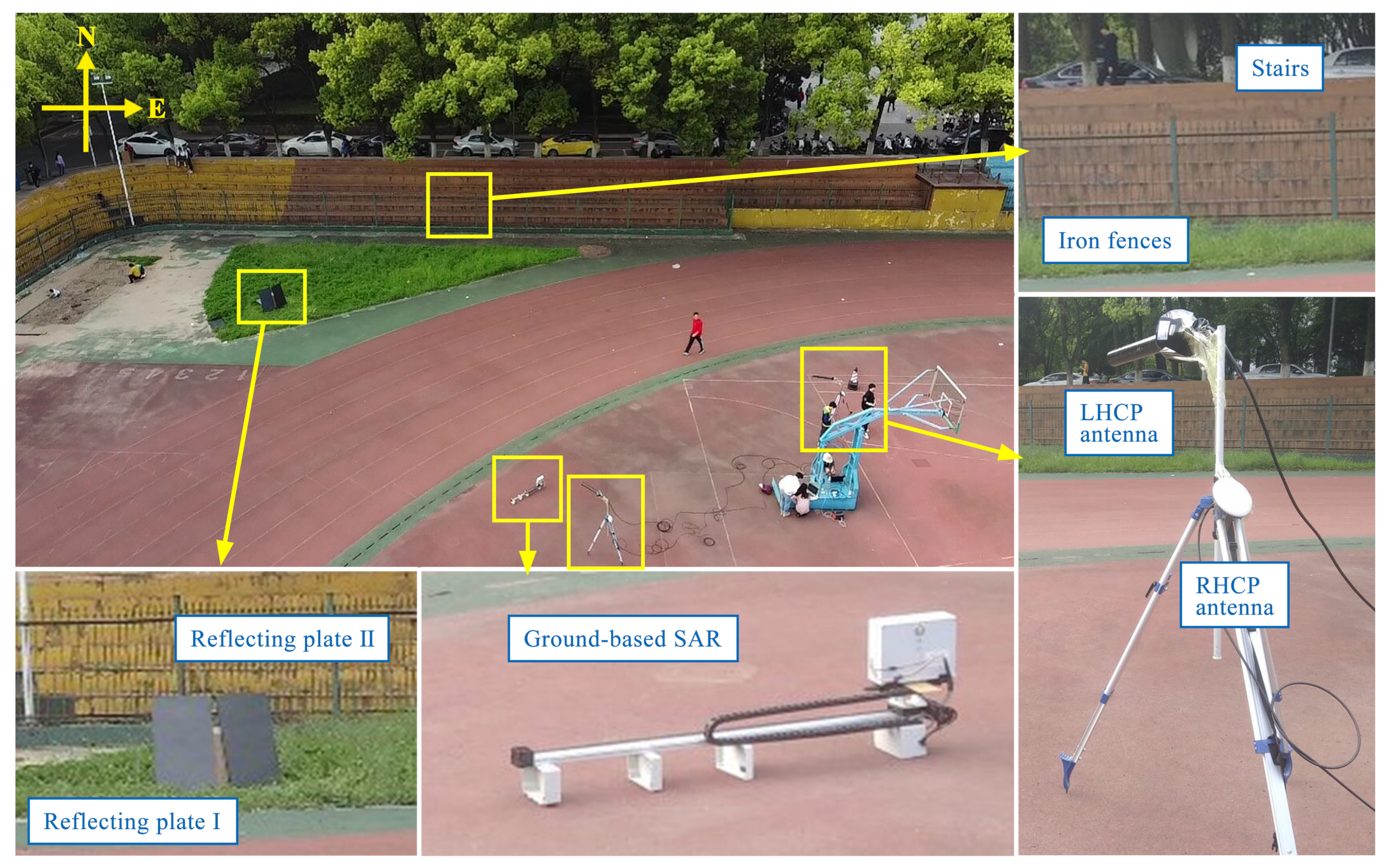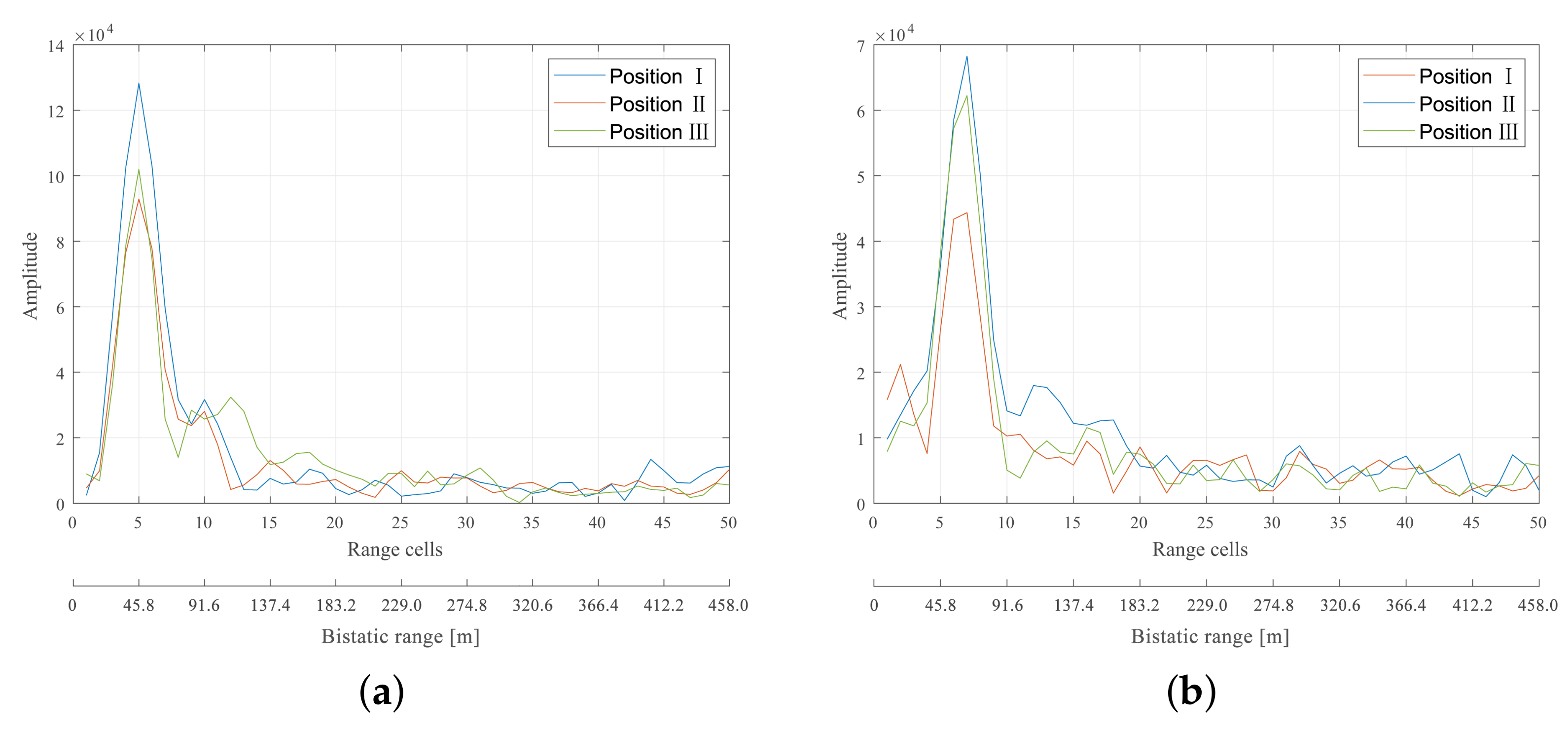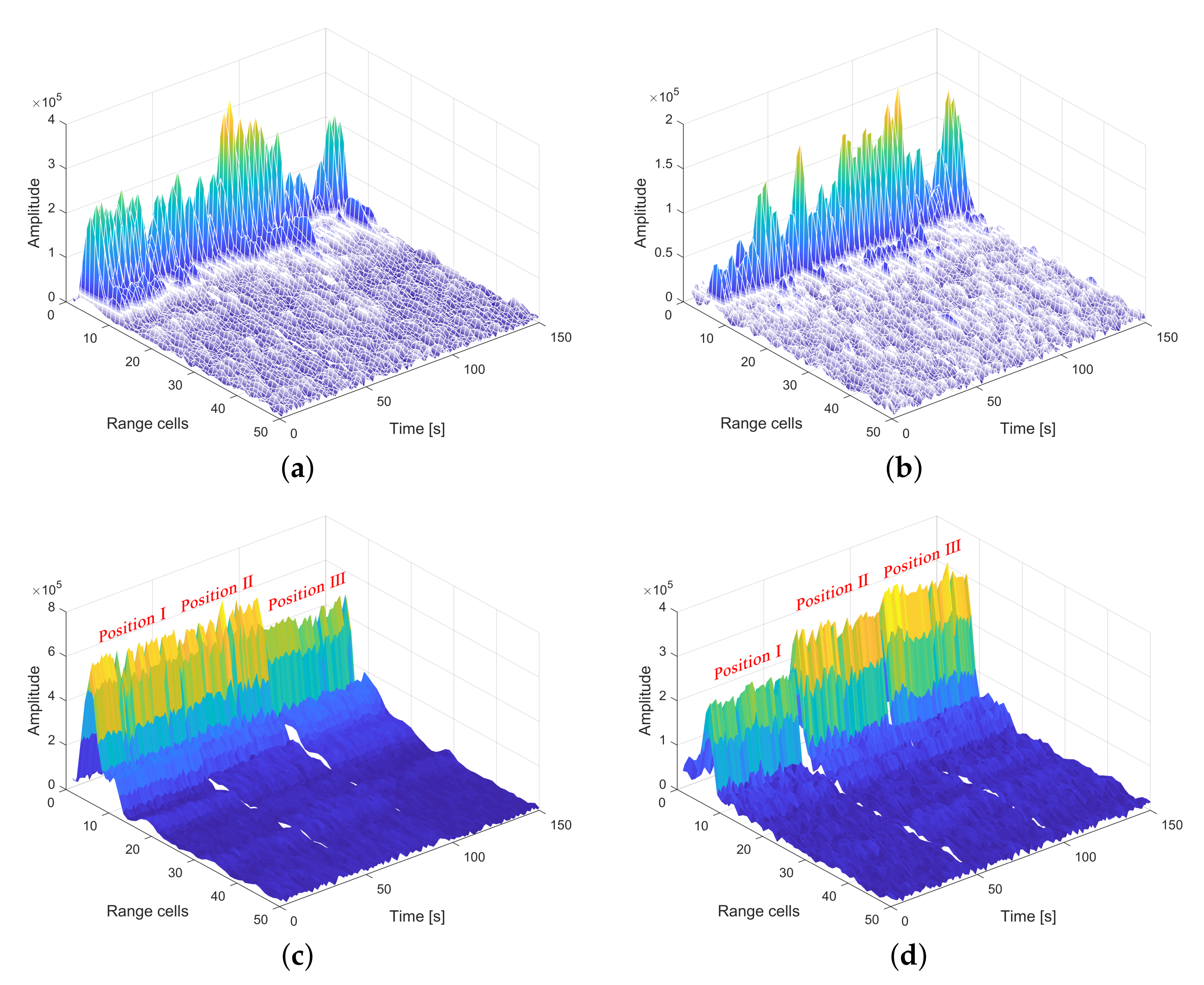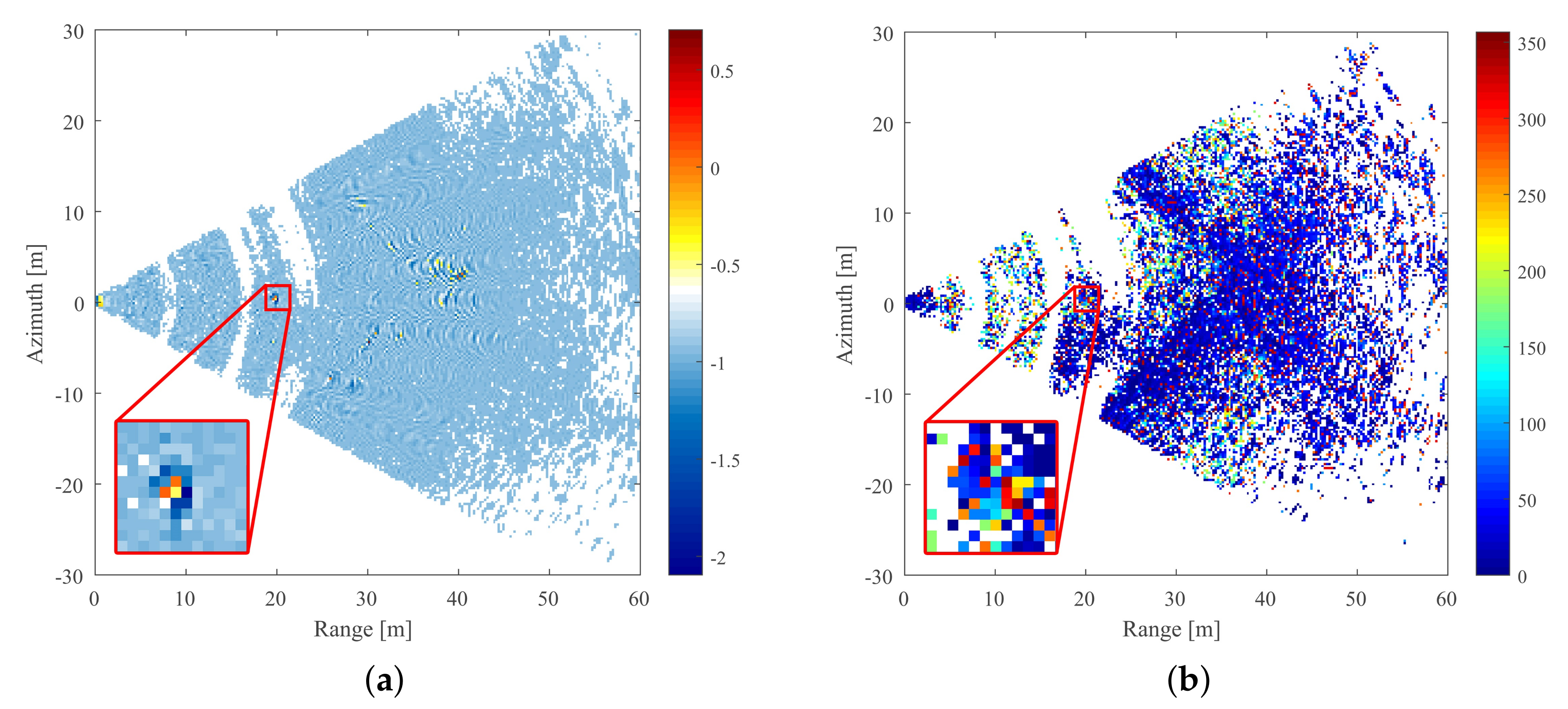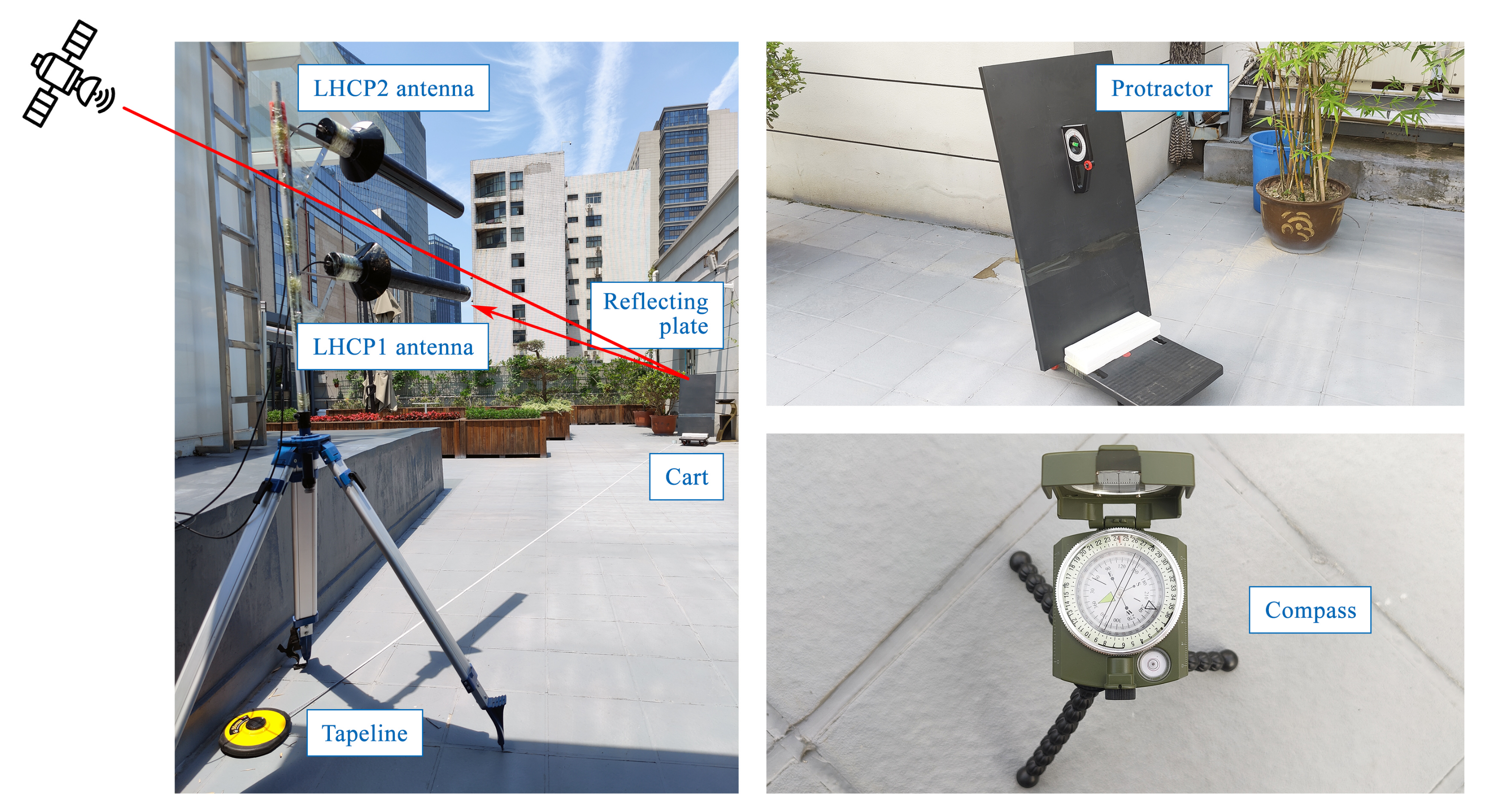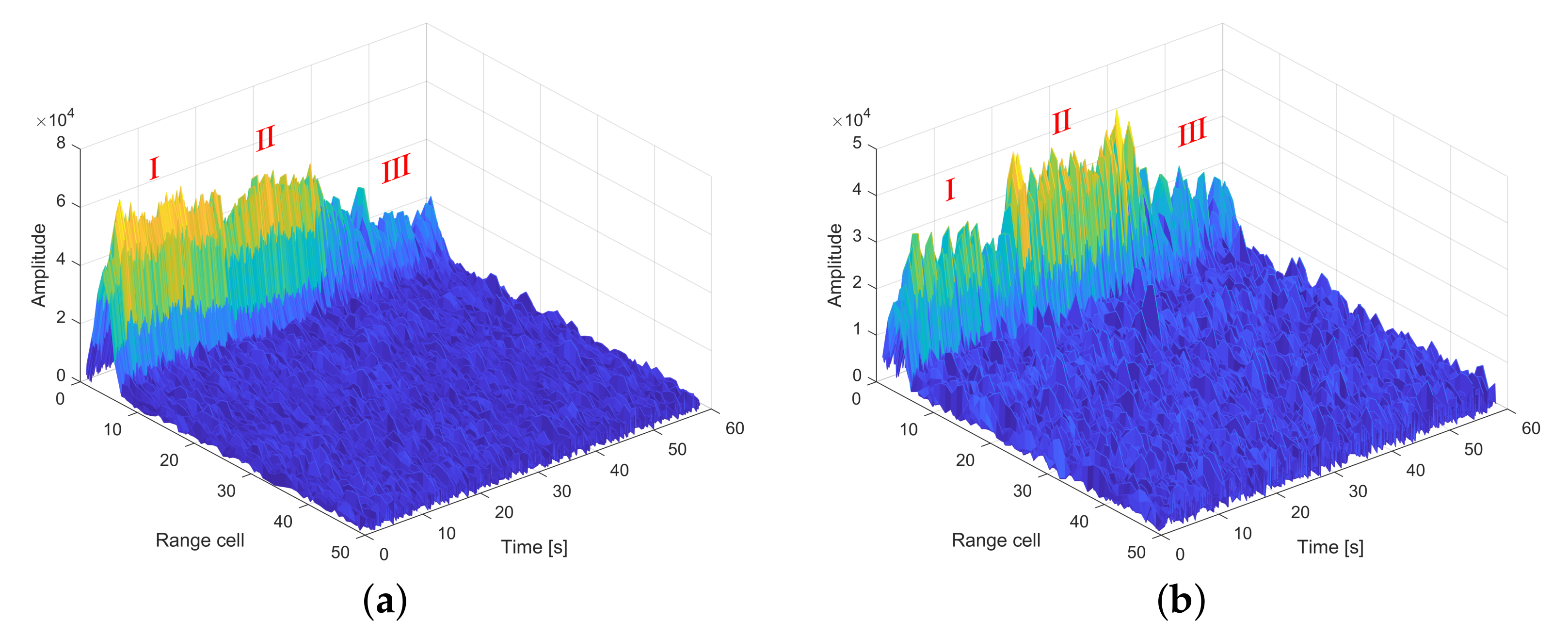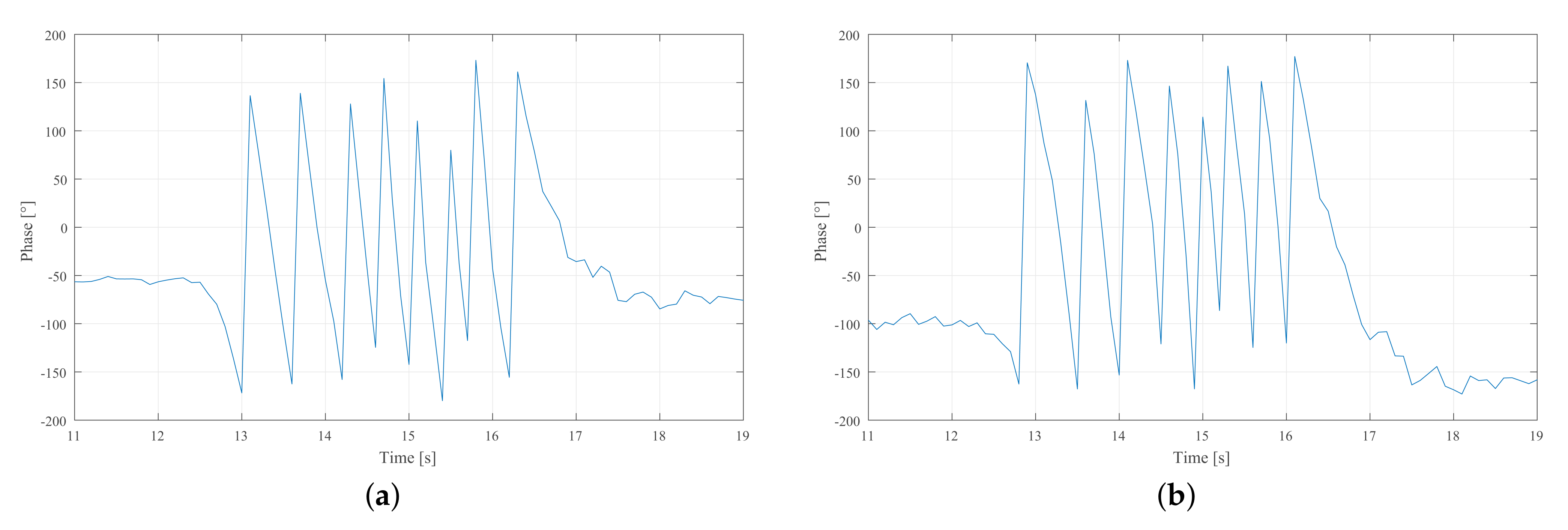5.1. Result Comparison with Ground-Based SAR
GB-SAR was also investigated as a possible tool for deformation estimation. The parameters of the SAR system are shown in
Table 4. Data collection was conducted before and after the artificial deformations displayed in
Table 2, the amplitude and the phase spectrum within range were obtained through conjugate multiplication with formula
[
29]. In particular, we concentrated on the phase variations since the deformation information is involved.
The normalized amplitude spectrum of the initial observation is shown in
Figure 10, and the provided geometrical information is consistent with Google maps and the aerial map.
Figure 10a depicts the strong reflection from the L-shaped iron fences and rear stairs. Four parallel lines are faintly visible, the first one of which is produced by the iron fences, located at a distance of approximately 30–40 m away from the observation point. The marked area in
Figure 10b shows the strong reflection from the target reflecting plates, which is at the range distance of 20 m and the azimuth distance of 0 m from the observation point. The target shape can also be distinguished as two rectangles overlapping with an obtuse included angle, and each rectangle covers an area of 2 × 2 pixels (pixel size equals range resolution by azimuth resolution of 0.25 m × 0.25 m). This result is due to the fact that the reflecting plates are inclined to the ground and not completely extended in range. Further details are given in the zoomed-in view.
The phase calculation results are presented in radians in
Figure 11a, in which there is a distinct mutation, indicating that the phase difference of the reflecting plates stands out of the background. As can be seen, the phase difference of the target central area is positive (yellow and orange), while it is negative (deep blue) for the adjacent edges. Moreover, the iron fences and rear stairs manifest themselves as interferometric fringes.
The phase variation spectrum is depicted in
Figure 11b in degrees. The target area is submerged in background random noises, while the positions of iron fences and rear stairs are marked by a deep-blue L-shaped area with a universal phase variation of less than 50 degrees. Similar features could also be observed with the GNSS-R-based method, as shown in
Figure 9.
Yet despite detecting some deformation in the target area, the GB-SAR estimation result has an incorrect order of magnitude based on the calculation. For this two-way estimating method and to satisfy Nyquist sampling theorem, the estimable deformation quantity is required to be less than one-quarter-wavelength [
30], while the Deformation I is 2 cm (>1.4 cm), causing severe deviations.
Benefit from the high positioning accuracy, GB-SAR has been extensively accepted as a typical deformation estimating tool. Compared to the proposed GNSS-R system, the GB-SAR has significantly improved range resolution (i.e., 0.25 m vs. the 30 m from proposed system). Meanwhile, the shorter wavelength (i.e., 5.6 cm vs. the 24 cm from proposed system) allows GB-SAR to achieve up to millimeter-level accuracy while estimating deformations. Nevertheless, its shortcomings are also obvious. GB-SAR system requires transmitter and ground track to form synthetic aperture, leading to a relatively high system cost and complexity. By contrast, the proposed GNSS-R deformation estimating system is distinguished by the advantage of low-cost and simplicity.
In our experiment, GB-SAR appears to be unsuitable for estimating deformations greater than several centimeters, which fall exactly within the best performing range of the proposed bistatic radar system. Inspired, the proposed bistatic radar system may be regarded as a supplement to GB-SAR in extending deformation estimation ranges.
5.2. Effect of SNR on Phase Stability and Deformation Retrieval
PSs generally exhibit a stable phase under high SNR in SAR reflection, and thus phase stability is considered a noticeable criterion. A number of physical structures, such as the reflecting plates and iron fences, were considered PSs during the experiment.
Figure 12a,b display the phase results extracted from the GNSS signals in three positions, from which the phase variations during the two deformations can also be determined. The results indicate that the extracted phases of echo signals from a stationary object perturb around their mean value, and phase stability varies with SNR. As marked by the red dashed boxes in
Figure 12a, a considerable amount of disturbance occurs during certain low-SNR processing periods and should therefore be excluded from the deformation results calculation. Accordingly, the most stable time periods (superior), the time periods with the most fluctuations (inferior), and the average-level periods (mediocre) for each collected dataset were selected (marked by black dashed boxes in both subfigures) for further analysis. In this case the selected time span is determined to be 10 s.
The phase stability and deformation estimation stability comparison results between processing periods with different SNR values are shown in
Table 5. In estimating deformation, we assume the last periods to be ideally stable. The results indicate that the phases and the estimated deformations are relatively unstable when obtained from the low-SNR periods, whereas a higher degree of stability is observed for the extracted phases and estimated deformations from the high-SNR periods. Additionally, such a quantitative discovery is in accordance with the conditions outlined in the dashed red box in
Figure 12a.
In future work on the monitoring of practical deformations, this discovery could provide guidance for site selection. Similar to PSs in SAR images, physical structures with relatively stable echoes in the deformed area, such as flat slopes, have the potential to be used as natural reflecting plates for GNSS-R-based deformation monitoring applications.
5.3. Study on Estimation Range Extension
According to the proposed reflectometry technique, deformation estimations can be accomplished by either code-based or carrier-phase-based approaches. With code-based (i.e., range compression) approaches, the estimation accuracy is solely determined by the limited bandwidth of Beidou B3I signals, which is inadequate for the majority of practical applications [
2], whereas for phase-based methods, which are typically restricted by the wrap problem, the phases are only measured modulo
, causing interger ambiguity issues (similar to SAR).
Technically, if deformation does not occur too rapidly (within one configurated CAI), then its variation trend is available to be identified in terms of phase temporal continuity. For simplicity, the term “overrange deformation” is used hereinafter to refer to certain types of deformation with an extracted phase exceeding one complete cycle. In order to provide a solution to the estimation of overrange deformations, a novel phase-based technique was introduced and preliminary validated through an additional experiment.
Given that the extracted phase is greater than , the overrange deformation quantity can be divided into fractional and integer parts. The step-by-step estimation process of the novel method is as follows:
- (1)
Continuously record the GNSS direct and echo signals.
- (2)
Perform phase extractions over the entire processing period, detect the deviants in phase (assuming that only one deviant exists within one certain time segment), and take the time segment in which the deviant arises into further analysis.
- (3)
Retrieve the fractional part of deformation quantity with the sums of phase variations at the beginning and the ending segments .
- (4)
Retrieve the integer part of deformation quantity
with the amount of complete cycles, which can be derived by subtracting one from the number of phase reversals
N. Consequently, the overrange deformation quantity
could be expressed as:
where
denotes the fractional part of deformation quantity and
denotes the integer part of deformation quantity.
To certify the theory, an additional overrange deformation experiment was designed and conducted at the rooftop of a building in Wuhan University, Wuhan, China (30
53′ N, 114
36′ E), on 23 June 2021. The experimental scenario is shown in
Figure 13, GEO C04 was employed as the transmitter, as well as a RHCP antenna and two LHCP antennas for data acquisition. With two LHCP antennas, a larger amounts of data could be available for analysis, which improved the credibility of the experiment. To ensure the temporal continuity of phase components, one reflection plate was mounted onto a cart and slowly translated towards the LHCP antennas.
Two datasets with different artificial deformation histories were separately collected for 60 s. While collecting dataset 1, the reflecting plate was kept stationary for three periods (0–12 s in Position I, 18–30 s in Position II, 35–60 s in Position III) and translated twice (12–18 s for Deformation I, 30–35 s for Deformation II). While collecting dataset 2, the reflecting plate was kept stationary for three periods (0–18 s, 22–35 s, 47–60 s) and translated twice (18–22 s, 35–47 s).
Figure 14 and
Figure 15 show the correlation peak results for the two datasets. With the bistatic range ranging from 26 m to 22 m approximately, the locations of correlation peaks remain unaltered within the 4th range cell over the entire data processing periods. In accordance with Positions I, II, and III, three periods with relatively stable amplitudes are marked using Roman numerals. The variations in amplitude among the positions are likely caused by the position variance of the specular reflection point, resulting in the echo signal being received by LHCP antennas from the angles of their lower lobe gain.
The continuous extracted phases are shown in
Figure 16, it can be observed that there are three stable phase segments representing three static positions of the target reflecting plate. The two segments of phase variations depicted by the green dashed boxes in
Figure 16a are produced by Deformations I and II, respectively.
The first phase variation segments from both LHCP1 and LHCP2 in dataset 1 are quantitatively analyzed as examples. As shown in
Figure 17, the LHCP1 phase component experienced eight phase reversals (i.e., seven complete cycles) and a residual phase variation of
, sum to the deformation estimation result of 99.0041 cm. Similarly, the LHCP2 phase component experienced eight phase reversals and residual phase variation of
, sum to deformation estimation result of 100.4068 cm. The deformation estimation results utilizing such proposed method are displayed in
Table 6.
According to the results, the proposed method is available of estimating overrange deformations with an accuracy better than 3 cm. The additional experiment produces a lower estimation accuracy than the preceding playground experiment. The reason for this could probably be the instability of echo phases from the jolting during translations and the errors in the ground-truth measurements. In addition, it should be noted that this method is not suitable for deformations occurring within a short time period, which leads to unpredictable phase reversals.
Due to the weak intensity of echo GNSS signal (i.e., intensity loss during GNSS signal reflection), the proposed bistatic radar system has certain requirements regarding the minimum energy of the echo signal, bringing limitations. Permanent scatters with enough RCS are required to generate stronger echo signal, so as to be accepted for processing. In addition, GEO satellite, reflectometry, and the target are required to be under appropriate geographical conditions and topologies allowing the bistatic radar to be constructed. Typically, the GEO satellites lie in the south of the observer in vast majority areas of China. As a consequence of the back-scattering model, receiver deployment in the south is also required to receive the echo signal from the northern reflector. In the future, further investigation of estimation error analysis will be worked.


